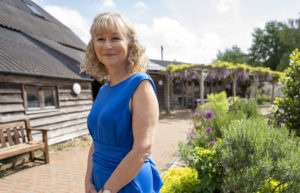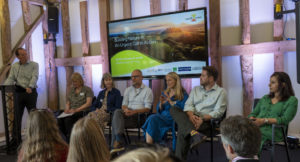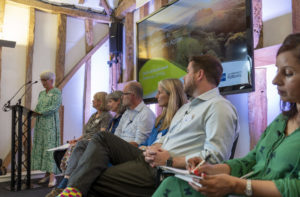Highlights from the Building Nature In event
By Verity Warne, May 2022
Can we design, build and live in places where people and nature thrive in balance?
May is always a special time at the Earth Trust Centre – the wisteria is in full bloom, pollinators are starting to get busy, nesting birds flit around the eaves of our buildings and school visits bring the excitement and delight of children to our ears. But yesterday the Centre was humming with even more energy and life than usual –more than 100 representatives from local authorities, advisory bodies, planning, construction & development organisations, social enterprise, and social & environmental groups met to discuss ‘Building Nature In’ to the places where people live, work and play.
The full recording of the event is available here, but in the meantime, below are key highlights from the day.
Earth Trust’s award winning Earth Lab building provided a living demonstration of 6 principles of Building Nature In which have been identified through our work to engage people in green spaces, nature and landscape heritage over the past 40 years.
Mark Beard, High Sheriff of Oxfordshire & Chairman of Beard Construction provided opening remarks, reminding us that society – and Oxfordshire – has a need for new – and better – homes, particularly for the most vulnerable, the homeless and young people. But in order to help realise benefits for climate, biodiversity, health & wellbeing the environmental and real estate sectors need to come together, with others, to think differently about partnership.
 Our CEO, Jayne Manley, set out the hypothesis to be tested during the discussion: Can we design, build and live in places where people and nature thrive in balance? To answer this question, Jayne emphasised that we need to share our passion, and different perspectives on what is important.
Our CEO, Jayne Manley, set out the hypothesis to be tested during the discussion: Can we design, build and live in places where people and nature thrive in balance? To answer this question, Jayne emphasised that we need to share our passion, and different perspectives on what is important.
“We at Earth Trust are social and ecological scientists, always questioning and looking for solutions,” Jayne said, “But most important is understanding and recognising that people make the difference. It’s not just me and it’s not just Earth Trust . This is about having a vision, enabling passion and building new approaches and new partnerships”. But, she continued, we need less debate and more dialogue to ensure that we truly hear each other as we develop a shared vision for the future.
 Jane Houghton, from Natural England talked about the support that the forthcoming Green Infrastructure Framework will give to local authorities and others by providing an England-wide evidence base to help target Green Infrastructure improvements where they are most needed. This, she said, aligns with the six principles being proposed.
Jane Houghton, from Natural England talked about the support that the forthcoming Green Infrastructure Framework will give to local authorities and others by providing an England-wide evidence base to help target Green Infrastructure improvements where they are most needed. This, she said, aligns with the six principles being proposed.
Julia Thrift, from the Town & Country Planning Association also supported the principles and welcomed the Green Infrastructure Standards Framework as an important contribution to explaining what ‘good’ green infrastructure is and how to achieve it. While we are starting to see good examples of what can be done, these examples often involve ‘fitting’ green infrastructure around the buildings. We need a radical transformation: the landscape and environment must come first, with the buildings designed to enhance and support them, not plonked in them. This means re-focussing our planning system so that it states, clearly upfront, in both law and policy, that the purpose of planning is to create places that support the health of people and the planet.
Peter Massini, from Future Nature Consulting, challenged the room to consider what building nature really means in an urban setting, making an appeal for more attention to be given to the solutions that nature offers and encouraging the design of spaces that draws on these solutions to benefit both people and nature. Ensuring that these discussions are relevant to the lives of people living in urban environments, is vital to the successful integration of green infrastructure and nature based solutions in both new development and regeneration work.
Rachel Stancliffe, from Centre for Sustainable HealthCare highlighted that while most of our evolution has been spent completely in a natural environment, we are now having to prove that humans need connection with nature to stay healthy. While hospitals have become very technical spaces, there are plenty of ways to bring in nature, including improving/extending the grounds and integrating health benefits for patients as a core part of the NHS. Rachel shared powerful examples of the NHS Forest, Nature Rangers, Health Routes and examples of new build hospitals – such as Alder Hey Children’s hospital – where consultation with patients, especially children has helped to deliver an exciting space centred around biophilic principles.
Ben Gardner, from Ecology by Design & Civity, talked about the potential of biodiversity net gain and offsetting to provide funding models for supporting better integration of nature with development. But, biodiversity net gain alone is not enough – instead, we need to think of “environmental net gain” or even, just “net gain” in order to unlock the full natural capital potential that offsetting can bring.
Geeta Ludhra, from Brunel University & Chilterns AONB emphasised that we must ve willing to get uncomfortable if we are truly prepared to put people at the heart of change. Geeta drew our attention to the diverse lenses of nature connection, and challenged us to consider the power dynamics at play that impact on whose voices and stories are heard, centred and re-presented when designing ‘connecting people and nature spaces’ and activities. Geeta commented “When the ‘right’ people are leading nature spaces, asking the ‘right’ questions and reaching out through deep cultural knowledge and lived research, there is always a way in. But the ‘deep’ work has to be done – we have to be willing to get uncomfortable and decentre dominant narratives of how people and nature connect.”
Matthew Battle from UKPropForums moderated the panel discussion, which included thinking about how we can work and masterplan at different spatial scales to enable people to get on and make change happen; what new models of partnership might be needed, and – the big question – how are our ambitions going to be funded.
 Jayne Norris from Edgars, drew the threads of discussion together in her closing remarks – reminding us all of the timeliness of this discussion: Covid has shifted our reality, and the public perception of the value of nature. We are also in the realms of legislative change. And because of that there is opportunity to comment on what’s coming from the government. But, she emphasised, “an opportunity is only that unless we take action”. Continuing to appeal to everyone present she asked us all to “Please make representations when there’s an opportunity at national planning policy level. … We need to collaborate and we need to keep collaborating…. It doesn’t matter if the conversation is difficult, the conversation has to keep going because everything that’s built from now on, without zero carbon or a biodiversity agenda being taken into account is a retrofit problem… Let’s use [our combined] talent and knowledge to create something real that’s better for everybody. Advocate to colleagues and get them to come visit here. The Earth Trust will show you examples of how you can build differently, how you can approach wildlife and biodiversity differently. And it’s a fantastic resource for the new generation to actually learn new skills and connect with nature. So please, I encourage you to take action, however small it may be, to make change. To focus, get up and go”.
Jayne Norris from Edgars, drew the threads of discussion together in her closing remarks – reminding us all of the timeliness of this discussion: Covid has shifted our reality, and the public perception of the value of nature. We are also in the realms of legislative change. And because of that there is opportunity to comment on what’s coming from the government. But, she emphasised, “an opportunity is only that unless we take action”. Continuing to appeal to everyone present she asked us all to “Please make representations when there’s an opportunity at national planning policy level. … We need to collaborate and we need to keep collaborating…. It doesn’t matter if the conversation is difficult, the conversation has to keep going because everything that’s built from now on, without zero carbon or a biodiversity agenda being taken into account is a retrofit problem… Let’s use [our combined] talent and knowledge to create something real that’s better for everybody. Advocate to colleagues and get them to come visit here. The Earth Trust will show you examples of how you can build differently, how you can approach wildlife and biodiversity differently. And it’s a fantastic resource for the new generation to actually learn new skills and connect with nature. So please, I encourage you to take action, however small it may be, to make change. To focus, get up and go”.
Watch the video to hear from some of the attendees on their thoughts from the day.
See our full recording for more.
